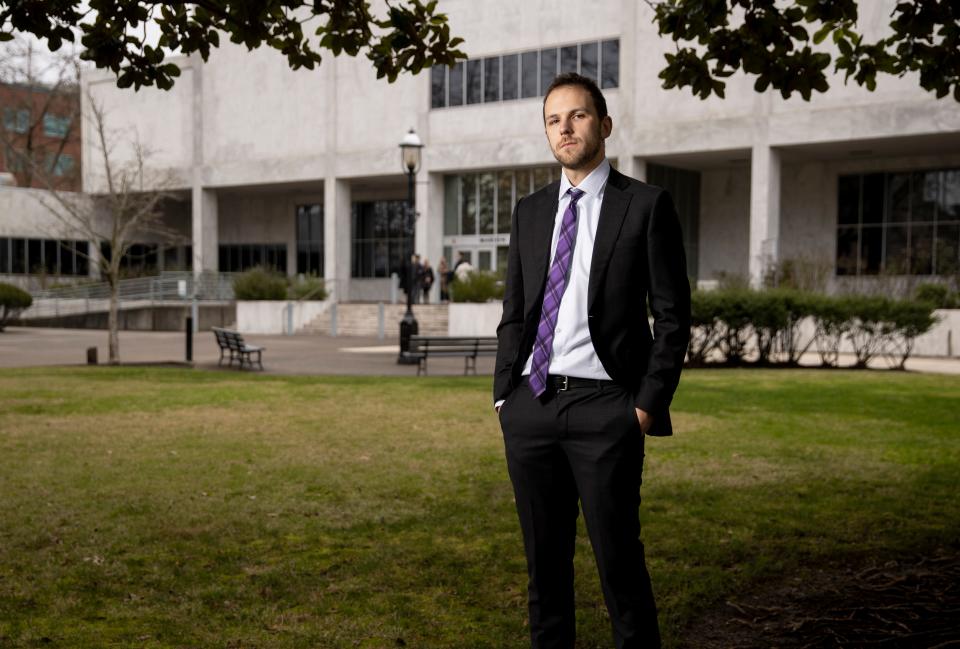Oregon is in an aid and assist crisis: How did we get here?

A 25-year-old man charged with burglary and assaulting and harassing his mother was released from the Oregon State Hospital in late January after reaching the end of his jurisdiction in a program to help defendants with behavioral health conditions.
Marion County Circuit Court Judge Audrey Broyles, deputy district attorney Evelyn Centeno and the man's lawyer, Kobin Patterson, met in Broyles' courtroom to decide the best option for the man's treatment. He had spent six months at the psychiatric hospital, and under a federal court order he had to be released.
They agreed the man still might not be able to help in his own defense and decided to have him enter the county's community restoration program, to continue learning legal skills and take prescribed medication while staying in a bed provided by the Psychiatric Crisis Center in Salem.

County courts across Oregon are making decisions on a daily basis about aid and assist patients as they are being released more rapidly than before under the court order.
The record-breaking number of aid and assist cases has become a crisis: There are not enough resources at the state hospital or in local communities to restore patients' abilities to aid in their own defense. And so they're increasingly being released from the state hospital, often to live on the streets and sometimes to commit new crimes.
U.S. federal Judge Michael Mosman in September ordered Oregon to release aid and assist patients with misdemeanor charges from the hospital within 90 days, felony charges within six months, and “violent felony” or “person-centered” charges within a year.
Disability Rights Oregon, a statewide disability advocacy group, and Metropolitan Public Defender, filed the lawsuit against the state as part of an effort to help defendants waiting in jail be admitted to the hospital sooner by releasing existing patients quicker.
The hospital has released 93 patients through January. But the number of defendants waiting in jails for state hospital admission, 105, is larger than anticipated.
Oregon State Hospital last year admitted more aid and assist patients than any of the other 24 state hospitals in the Western Psychiatric State Hospital Association. 2022 also marked a historical high for the hospital, serving 1,290 aid and assist patients across both the Salem and Junction City campuses.
Sometimes the courts are unable to place these individuals in restorative care due to a lack of resources and housing options, or because they cannot provide the level of care needed.
Many aid and assist defendants are homeless. Some in the criminal justice system believe recidivism at the state hospital could drop if administrators tracked patients' housing status and worked with homeless advocates and organizations to ensure continuum of care upon release.
Capacity at the state hospital has also been a challenge, as there is not enough space to hold everyone waiting to be admitted and pandemic-related staffing shortages continue.
The aid and assist crisis has left local and state officials seeking solutions like increasing the number of treatment facilities throughout the state and allowing more capacity at the state hospital for civil commitments.
Limited hospital resources, staffing
The state hospital population has changed the past three years. In 2022 nearly 91% of the patients admitted to the hospital were aid and assist, compared with less than half in 2019, according to Oregon State Hospital data.
Oregon State Hospital superintendent Dolly Matteucci said the hospital once had the capacity to serve three patient populations:
Aid and assist patients who might have symptoms of a mental illness, be unresponsive, struggle to understand and communicate with their lawyer, or refuse to collaborate with their lawyer.
Guilty except for insanity patients committed by the Oregon Psychiatric Security Review Board after determining they committed a crime but did so without intent due to their mental illness.
Civil commitment patients who can voluntarily or involuntarily be committed because they pose an immediate danger to themselves or others.
When the patient population began to shift in 2019, the hospital “could not keep up,” Matteucci said.
“It’s a very difficult dynamic to manage,' she said, and difficult for staff to provide the care required for some patients.

Something had to give.
Matteucci said the hospital prioritizes aid and assist patients and places strict requirements on civil commitments. Only 11 civil commitment patients were admitted to the state hospital in 2022, according to state hospital data.
Aid and assist patients often come to the hospital having received no prior mental health treatment, she said. They are sometimes experiencing severe symptoms of their mental health condition, such as psychosis, within the first 60 days in the hospital.
“It takes a lot of time and energy from the clinical professionals and the unit staff to identify what the needs are and to provide those needs,” Matteucci said.
With a larger percentage of the patient population needing a higher level of care and clinical staffing shortages due to the pandemic, state hospitals have faced capacity challenges.
“You feel that instability … not feeling like you are in a position to do your best,” Matteucci said. “So, that impacts individuals, the unit, and the overall sense of morale.”
County jails, law enforcement pick up the slack
Legally, defendants are not supposed to wait in jail for more than seven days in accordance with the 2002 Mink order.
The Mosman order was issued because the state hospital failed to meet August admittance wait-time benchmarks. The wait-time standards were set by Dr. Debra Pinals, a neutral expert chosen by the Oregon Health Authority, Disability Rights Oregon, and the Metropolitan Public Defender to create a plan to address capacity challenges.
Pinals has submitted four reports since January 2022 with plans for getting patients in and out of the state hospital quicker. The hospital has struggled to execute them.
The state hospital used archival data to predict the number of discharges, admissions and new aid and assist orders, but each month the actual number of admissions and new orders have been higher than previously projected.
The state hospital has mostly met patient discharge benchmarks since the Mosman order was issued.
Wait times for admittance to the state hospital, however, have not significantly decreased due to the volume of increased new orders for admission. At the end of January, the average wait time for admission was 39.2 days, according to Oregon Health Authority data.
At the end of January, 105 defendants were waiting in county jails for admission to the state hospital in Salem or Junction City.
Jails are not mental health treatment facilities, though, said Ann-Marie Bandfield, program manager at the Psychiatric Crisis Center in Salem. The state-funded center provides treatment and can connect individuals experiencing a mental health crisis with housing.
“If they're coming out [of the state hospital] for community restoration, we try to do a discharge the same day or next day from the jail because we don't want people to go backward while they're at the jail,” Bandfield said.
The Psychiatric Crisis center plays a large role in Marion County’s community restoration program, providing legal skills classes, connecting defendants with medical providers, and offering beds for those who need them.
Marion County jail has a provider who can prescribe medication to defendants, but there is always the risk of them getting worse or backtracking while either waiting for a state hospital bed or to go into community restoration.
There were 8 defendants on Monday in the Marion County Jail waiting for a state hospital bed.
Marion County commissioners Kevin Cameron and Colm Willis said neither the jail nor communities are the right place for individuals with “severe and persistent mental illness.”
“Everyone should be concerned about this,” Willis said.
Pressure on county courts
It is up to community behavioral health and criminal justice systems in the county where aid and assist patients were charged to arrange for transport and determine placement when they are discharged from the state hospital.
If they are able to aid in their own defense, their trial can proceed. Some patients are released still unable to aid in their defense because they have reached the end of their jurisdiction at the hospital.
Treatment options and community resources vary by county. In Multnomah and Marion counties, the first and fifth most populous counties in Oregon, community restoration programs are more robust than in more rural counties, such as Polk County.
Aaron Felton, Polk County's district attorney, described the aid and assist “crisis” as “one of the most profound challenges” in his career.
Felton said Polk County courts and behavioral health do not have the resources to treat an increased number of aid and assist defendants being discharged into the county.

In Marion County, community restoration involves attending a hearing before Judge Broyles, who asks if the defendant has completed legal skills classes, met with staff at the Psychiatric Crisis Center and been compliant with medication requirements.
Many counties now have a dedicated behavioral health prosecutor, such as Evelyn Centeno, the Marion County Deputy District Attorney. Catherine Trottman also serves as a dedicated mental health defense attorney in Marion County.
Broyles works with Centeno and the defense team, often including Trottman, to determine a treatment plan within the community for qualifying defendants or those released from the state hospital.
Sometimes defendants are experiencing severe mental health symptoms and are not able to actively participate in community restoration, which requires a level of personal accountability and cooperation not required at the state hospital.
This often means charges are dismissed due to a lack of other options. In some cases, a defendant may be deemed “never able” to aid and assist.
This decision to dismiss charges or deem a defendant 'never able' can pose a public safety issue, said Paige Clarkson, Marion County district attorney.
“The Mosman order fails to account for either the individual dangerousness of the crime nor the gravity of one’s mental illness before returning that person to our jail untreated and unprepared to face criminal charges,” Clarkson said. “This leaves them in legal limbo, too dangerous to release to our community, but too sick to be fairly and justly prosecuted.”
If someone poses a danger because of their behavioral health condition, they could end up hurting themselves or someone else and back in the criminal justice system.
Early releases from the state hospital or dismissal of charges also can be unsettling and confusing to victims expecting more time to emotionally and physically prepare for their perpetrator’s discharge, Multnomah County Deputy District Attorney Channa Newell said.
Homelessness contributes to recidivism

Spencer Todd, a Marion County public defender, said many aid and assist defendants experience homelessness. Once they are no longer at the state hospital, they may have nowhere to go.
If the defendant cannot stay in community restoration and their charges are dismissed, Todd said, they may end up unhoused and in situations that exacerbate their behavioral health condition rather than help it.
“If we don’t solve the problem and they’re just back on the street, they’re going to reoffend,” he said.
Trottman echoed Todd's concerns: “I just foresee it becoming a revolving door.”
Clarkson, Newell, Todd and Trottman agreed the prevalence of individuals with persistent mental illness experiencing homelessness may be contributing to the recidivism of aid and assist patients at the state hospital.
The Oregon State Hospital does not track patient housing status before patients are admitted or when they are discharged.
“The work of OSH is to care for the patients while they are under our care. It is out of our scope, and we are not set up to track patients before and after,” the hospital said in a statement to the Statesman Journal.
Can we solve this crisis?
One proposed solution for decreasing the strain on the state hospital, county jails, law enforcement and the courts is building more state-funded residential psychiatric treatment facilities.
Trottman said the facilities would provide less-intensive care than the state hospital but still offer housing and mental health care.
As of March 2022, there were 1,342 beds at licensed residential treatment facilities across Oregon, according to Oregon Health Authority data. Throughout last year, the Oregon Health Authority granted funding to build treatment centers in 10 counties, adding 198 beds.
Caring for some aid and assist patients at residential treatment facilities rather than at the state hospital might allow more capacity for civil commitments.
The state hospital is meant to provide the highest level of care to patients, so if someone is posing an immediate threat to themselves or others, ideally they could go to the hospital on a civil commitment.
“There are certain people where the hospital is the only spot for them,” Todd said.
In a best-case scenario, Trottman and Todd said, individuals with behavioral health conditions need help before their offense even occurs so they can avoid the criminal justice system altogether.
“The hospital and restoration services are not designed to make someone truly better,'' Trottman said. "They’re designed to restore them enough to handle their criminal case.”
Todd added the lack of resources in the behavioral health system "does damage to the victim, to the defendant, to the future victim that we don’t even know yet."
Sydney Wyatt covers healthcare inequities for the Statesman Journal. Send comments, questions, and tips to her at SWyatt@gannett.com, (503) 399-6613, or on Twitter@sydney_elise44
The Statesman Journal’s coverage of healthcare inequities is funded in part by the M.J. Murdock Charitable Trust, which seeks to strengthen the cultural, social, educational, and spiritual base of the Pacific Northwest through capacity-building investments in the nonprofit sector.
This article originally appeared on Salem Statesman Journal: Oregon aid and assist crisis state hospital Salem Junction City
